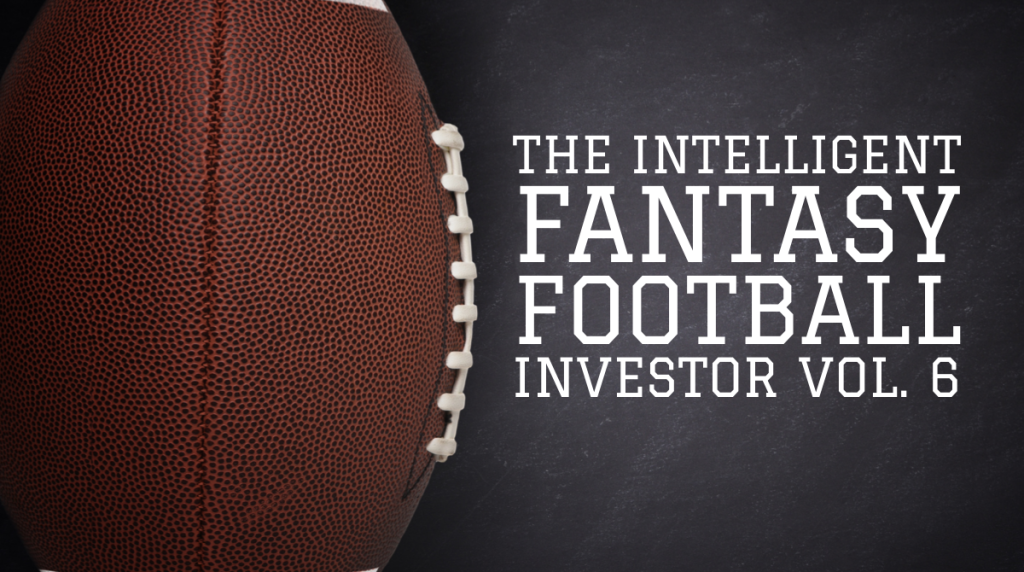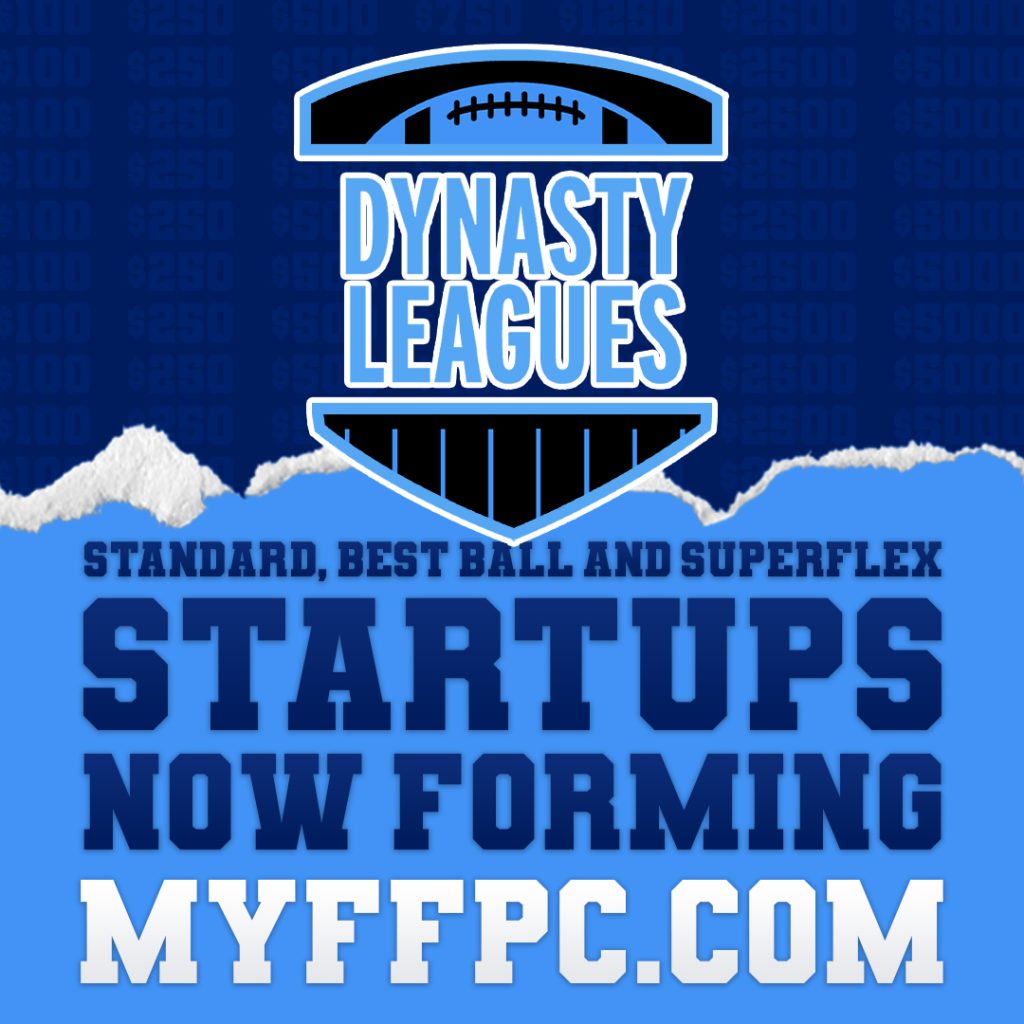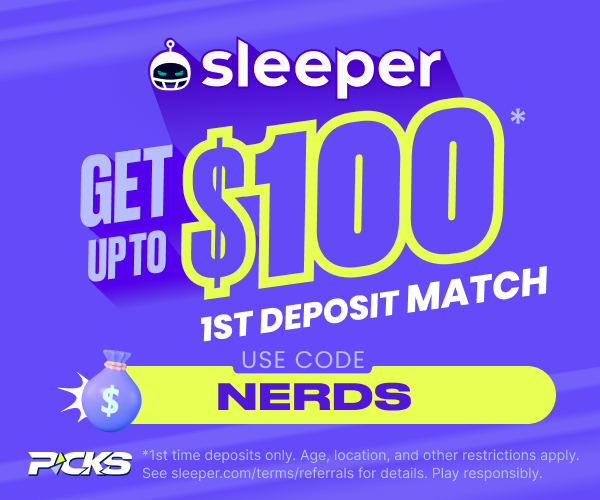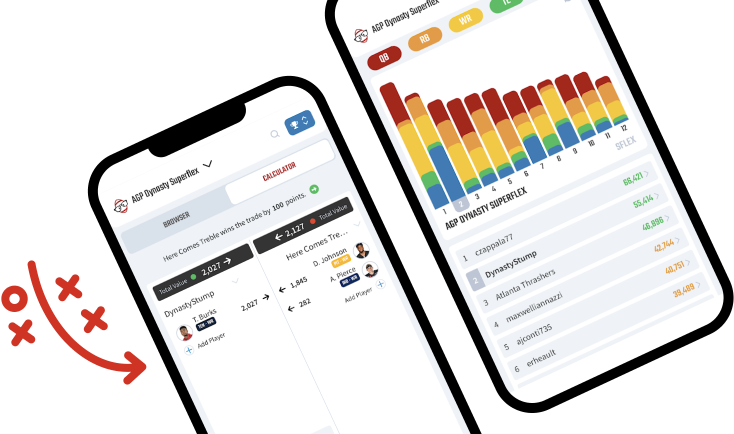This series builds off each volume, so if you haven’t read The Intelligent Fantasy Football Investor Volumes 1-5 yet, please stop now and read them here. The purpose of this series is to bring investment concepts and a different thought process to the fantasy football community.
The premise is that we should value fantasy players based on the relationship between a player’s price and his earnings. Or his P/E ratio. Price is the number assigned to him on KeepTradeCut(KTC). KTC = Price. Fantasy points on a per-game basis (PPG) are a player’s earnings. So, putting it all together: P/E = KTC / PPG (note: divided by 10 for simplicity). When comparing similar assets (like for like), the lower the P/E, the more value you get from that player. The best way to use P/E is to look at clusters w/in each position group for value.
Now let’s look into more investing concepts and apply some of these valuation concepts to tight ends.
Value
I’ve been talking about value in this series, but what does it mean? The concept of value or value investing is just about buying something for less than its fundamental worth. Value sometimes gets a bad rap. Because people think it means being cheap or buying really low-priced assets, but that’s not it. It’s about the price you pay being less than what the asset is worth.
In fantasy football, there are lots of ways to look at value. A couple of ways analysts measure value that I particularly like are Wins Above Replacement (WAR) & Fantasy Points Over Expected (FPOE). You can also think of ‘getting value’ while drafting by selecting players lower than their average draft position (ADP). The point is there are many ways to measure and think about value in fantasy football. And I encourage you to explore all of them.
Win now
One comment I have gotten a few times from readers of the series is, “Jay, you always take the value perspective, but if I’m pushing for a title, I won’t sell CeeDee Lamb or Javonte Williams.” [both of them are on my sell list]. I think value as a strategy can sometimes be controversial. I mean, two months ago, you could have done this: Javonte Williams = Derrick Henry + 2023 1st. You are arguably better positioned for a ‘win-now’ title. And you get to re-shoot on another 1st round draft pick in 2023. They may not be as flashy, but I think the guys on my Top Buys list are ‘good players’ as well. It’s just that they are cheaper than the Sells, and that’s where you create value.
Win [now] at a reasonable price (WARP)
The P/E ratio is not only about price. It’s about price vs. fantasy points. When people talk about the strategy of ‘win-now,’ they are largely referring to, simply put, their team scoring tons of fantasy points. And guess what, when we are talking P/E, we are talking fantasy points. In fact, it’s how do I get the most PPG for the lowest price? To me, that very much can be a ‘win-now’ strategy, but it’s not ‘win-now’ at any cost. It’s ‘win-now’ at a reasonable price (WARP) while also increasing your odds of success in the future. Yep, that’s a new dynasty strategy that I just came up with. You heard it here first, WARP! And that’s what we are trying to do here with P/E analysis, win now at a reasonable price.
Value Trap
Now I’ve talked a bunch about the positive attributes of a dynasty strategy based on value. However, there are pitfalls associated with value as a strategy. One common one in investing is called a value trap. A value trap is when a stock/asset trades at a cheap valuation (low P/E), making it appear an attractive investment. However, there are fundamental reasons why it is trading cheap, and it likely will trade cheaply for a while.
Stocks stay cheap if they hire a bad CEO or assemble a poor board of directors. These people can end up destroying value. The company’s product could have lost viability and is no longer relevant (think Blackberry or Blockbuster). Or a company’s end markets become permanently impaired because of collective societal changes like the U.S. and Europe focusing less on fossil fuel industries which limited investment in the industry, causing most companies related to those industries to trade cheaply for a very long time.
Value Traps applied to Fantasy Football
The same things can happen in fantasy football. Just because something is cheap or trades at a low P/E doesn’t mean it’s a good investment. It could be a value trap. Just as a matter of math, a low P/E means that a player either has a low price relative to his peers that score similar PPG, or he scores more points relative to his peers at a similar price.
From a PPG perspective, a player could be trading at a low P/E because of a perceived age cliff approaching. That player could continue to put up points for years without hitting that age cliff. Meaning he is maintaining a low P/E no matter how many points he scores. His P/E stays low, and you never get P/E multiple expansion. Thus that player could be a value trap.
Age cliff isn’t the only explanation; just like stocks, it could be because of leadership (Owner/GM/Coach vs. Board of Directors/CEO). Some organization owners continue to hire the wrong people, and player values suffer. Or, for example, a wide receiver on a team with a coach that values the run more than the pass. The wide receiver in that scheme will trade at a discount to a wide receiver in an offense with more focus on passing volumes. Coaches that don’t focus on the passing game can create value traps for certain wide receivers because those players’ P/Es will always be low given their exposure to that scheme.
Value Traps – Hope vs Reality
Sometimes a player trades at a low P/E because they trade at a low price. But there is hope that, for whatever reason, his numbers will improve. However, maybe the player just isn’t that good, and regardless of how much opportunity he gets, his price won’t appreciate. This gets into hope vs. reality, which is one of the major pitfalls that could lead someone to fall into a value trap. Hope is not investing, and it usually results in the loss of money and a waste of time.
The point here is that value as a strategy has its merits. But there are also downsides if not applied appropriately. You should be careful and make sure you fully understand the context and situation of players so that you don’t accidentally fall into a value trap.
And now on to valuing tight ends from a P/E perspective.
Clusters
Each player is put into a ‘cluster’ of players with similar production levels, age, and upside potential. Clusters separate players into like-for-like categories, making it ideal for P/E ratio analysis. Please read more about clusters on Twitter from @DFBeanCounter of Bulletproof Fantasy Football.
Here is a chart that shows the average P/E for each tight end cluster using KTC prices on 5/22/22.
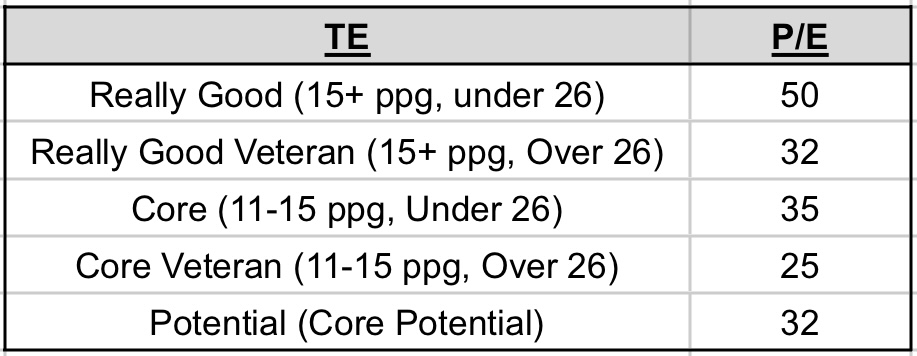
Top Buys
Now going through all the clusters and comparing each player’s current P/E with his cluster’s average P/E, you can come up with a target price & target P/E for each player. Then you can calculate the upside or downside from the player’s current price. After doing that analysis, here are my tight end top buys.


We still are waiting to find out if Gronkowski comes back. If he comes back to play with Tom Brady this year, he is worth a lot more than his current price, given how many PPG he produces. At his current low cost, you might as well take a shot on him coming back for one more run at a championship with Brady and the Bucs.
Fant may be one of the biggest losers from the Russell Wilson trade to Denver in that he was moved to Seattle. Regardless of who ends up being the quarterback in Seattle this year, it most likely will not be top-end quarterback play, so it’s hard to imagine Fant producing at very high-end levels. However, Fant can produce at high levels; he just needs the quarterback play to get there, and at some point, hopefully, he gets that from a dynasty perspective.
Jordan had a decent rookie year for a fifth-round tight end and ended up being a winner from this year’s offseason, given he wasn’t replaced as a starter in the draft or free agency. Say what you will about the Texans offense, but someone will have to catch passes from the tight end spot. I’d always be worried that he could be replaced, but his price is pretty low on KTC, so he’s worth a low-cost shot.
Is Kyle Pitts a unicorn?
Pitts is a unicorn. What does that mean? In this case, it means Pitts is a wide receiver playing tight end. As a manager, you are getting wide receiver production from the tight end position. That makes him one of the most valuable players in dynasty fantasy football because of the strategic advantage he offers when setting lineups. Because of this advantage, Pitts should be considered a first-round pick in tight end premium leagues and should be considered early second in non-tight end premium leagues.
Currently, Pitts is the highest-priced tight end with a KTC of around 6850. And given that he only scored ~10.5 fantasy points per game, his P/E is one of the highest in the tight end group. Ordinarily, that would put a player on my sell list. However, because of Pitts’ strategic advantage and that I’m expecting some touchdown reversion in his next year, I think his PPG will be on the rise, and his P/E ratio will fall into line.
So I’m not advocating a sell on Pitts. He’s more of a ‘hold’ for me. If you can buy at a reasonable price (unlikely) or grab him in a startup draft, I would recommend doing that, given his strategic advantage and high price. However, if you wanted to practice the art of compounding, I’d understand if you wanted to sell him for a good tight end and a good pick. Keep in mind that you are selling a unicorn, and he should be priced accordingly.
Top Sells
None. Not trying to be cheeky here. There are just so few decent tight ends out there that if you find one that works for you, maybe just hold onto him. Now that’s not to say there aren’t overpriced tight ends (maybe Goedert or Albert O or Pat F), just that there aren’t any that are so overpriced they warrant a Top Sell recommendation.
Pairs Trade

My first pair trade recommendation was Justin Fields vs. Trey Lance. I’m going to add to that with another pair trade of Noah Fant vs. T.J. Hockenson. As a reminder, the concept of pair trading is two very similar assets, where one is overvalued and the other is undervalued relative to each other, so you buy the undervalued one and sell the overvalued one. The hope is that their prices converge over time, and you can reap the rewards.
The fun part about this trade is that these guys were teammates in college, then both entered the NFL as first-round picks in 2019. I like both of these tight ends. However, Hockenson is ~2000 KTC higher than Fant, and it is my opinion they should trade at similar prices. I’m not sure if that means Fant moves up 2000 KTC, Hockenson moves down 2000 KTC, or they meet somewhere in the middle. Just that their prices should converge over time, if you put this idea to work, I think you can create some value.
Again, when I say someone is a sell, I’m saying they are a sell at the current KTC prices. I’m not saying you sell for peanuts just to offload him. If you can’t get the premium price on a sell, then hold. And, remember, these recommendations have nothing to do with the players themselves and have nothing to do with real football. All we are doing is applying valuation techniques to fantasy football.
Example trades
T.J. Hockenson [Sell] = Noah Fant [Buy] + 2022 Early 2nd
Albert Okwuegbunam [Sell] = Rob Gronkowski [Buy] + 2022 Mid 2nd
Pat Freiermuth [Sell] = Brevin Jordan [Buy] + 2022 Early 2nd
Value Traps applied to TEs
The tight end position group is riddled with value traps. Austin Hooper & Hayden Hurst both trade at pretty cheap P/E ratios. Does that mean that just because they are relatively cheap that their prices will appreciate to closer to their peer average? No. You have to consider context and situation and make sure you understand that just because a player looks cheap, it doesn’t mean they are a good investment. It’s likely that Hooper & Hurst are cheap for a reason and might be great examples of what to think about when you are thinking about value traps.
Removing Tyreek Hill from my Top Sells List
Sometimes an idea works. You don’t have to wait for ages for it. It just plays out as you expected. On February 10th, 2022, I added Tyreek to my Top Sells list. He was trading at a KTC of ~6000. Using my P/E analysis, I put a target KTC of ~5050 on him. Currently, Tyreek trades at ~5150. That means Tyreek’s KTC has depreciated ~13% since being added to the Top Sells list, and he is within 2.5% of my target KTC. At this point, I’d say the idea/trade has worked, and I am formally moving Tyreek off my Top Sells list to a recommendation of hold. I hope you were able to capture some value with this trade, but as of now, I am no longer recommending Tyreek as a sell.
Reminder: around mid-summer, we will roll the P/E ratio forward and move from actual 2021 PPG to projected 2022 PPG.
Conclusion
Much of the Intelligent Investor series has been about applying value to fantasy football. Using value strategies can help a dynasty player create winning rosters for now and the future. But be careful. Value strategies aren’t all sunshine and rainbows. There are many pitfalls, including what we discussed today, value traps.
We also used P/E value techniques to add Rob Gronkowski, Noah Fant, & Brevin Jordan to the Top Buys list. And came up with an interesting pair trade of, long Noah Fant vs. short T.J. Hockenson, which currently trade ~2000 KTC apart. Finally, we are closing out the Sell Tyreek Hill trade, which worked to the tune of ~13% and came to within ~2.5% of my price target from February 2022.
If you are interested in learning more about Dynasty/Devy fantasy football, please follow along on Twitter @_jasonstein and let me know what questions you have and how I can help.

